AMD Entry-level PC
A year ago our entry AMD was single-core, last December 40% less money bought a 2.6GHz dual-core system, and today's AMD entry system uses a Black Edition unlocked 2.7GHz dual-core that costs a few dollars less than our choice just three months ago. That is certainly increased value in an economy that forces most buyers to look closely at price. With memory so cheap we have continued our recommendation of 4GB at a kit price of just $37. You can go with 2GB and save $18, but that money is well spent in doubling memory. The hard drive remains at 500GB.
| AMD Entry-level PC | ||
| Hardware | Component | Price |
| Processor | Athlon 64 X2 7750 Kuma 2.7GHz Black Edition (2.7GHzx2 95W 2x512KB L2) |
$60 |
| Cooling | CPU Retail HSF | $- |
| Video | On-Board | $- |
| Motherboard | ASRock A780GXE/128M 780G | $80 |
| Memory | G.Skill 4GB (2x2GB) DDR2-800 | $37 |
| Hard Drive | WD Caviar GP WD5000AACS 500GB | $60 |
| Optical Drive | Samsung 22X DVDRW/DL SH-S223Q | $25 |
| Audio | On-Board | $- |
| Case | SIGMA La Vie ABWBP Black Aluminum/ SECC ATX Mid Tower with 500W Power Supply | $60 |
| Power Supply | Included with Case | $- |
| Base System Total | $322 | |
| Display | Hanns-G HB-175APB Black 17" 8ms Widescreen LCD Monitor Built in Speakers - Retail (1440x900) | $99 |
| Speakers | Built into Monitor | $- |
| Input | Microsoft CA9-00001 Black PS/2 Standard Keyboard and Optical USB/PS2 Mouse - OEM | $16 |
| Operating System | Microsoft Vista Home Premium OEM | $99 |
| Complete System Bottom Line | $536 | |
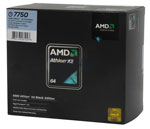 |
Prices on all processors are continuing to drop in the face of the aggressive pricing strategy adopted by Intel in entry to upper midrange processors. The $60 AMD 2.7GHz dual-core is a faster CPU at a slightly lower price than our December guide. Not only is it faster but it's also a Black Edition (unlocked) CPU. Most have been easily running at 3.0GHz just by increasing the multiplier. If you want even more power the Phenom 8750 triple-core Black Edition is a good value for just $44 more ($104). However, for most users the Athlon 64 X2 7750 provides plenty of power for an entry system. If you're counting pennies you could drop down to a single-core 2.6GHz Orleans 45W processor for $42 and save $18.
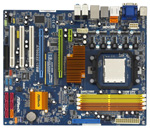 |
The 780G chipset is one of the best budget IGP designs we have worked with over the years. This is the chipset that made integrated graphics relevant again. One of the best boards in this price category is the ASRock A780GXE. The A780GXE features AMD/ATI Radeon 3200 integrated graphics. ASRock loads the board with six 3Gb/s SATA ports featuring RAID 0/1/10, 5.1 HD Audio, Gigabit LAN, two PCI-E x16 slots, one PCI-E x1 slot, three PCI slots, and support for 16GB of memory. Durability is addressed with solid capacitors for CPU power and duracap long-life capacitors for the rest. This board has been rock solid for us and supports AM2/AM2+ and the newest AM3 CPUs. The A780GXE has 128MB of sideport memory for additional performance. It fully supports the 140W Phenoms, and it can do dual x8 CrossFire. The A780GXE used to be a $100 board, so it is a good value at the current $80 price. It is ATX format, and ASRock also manufactures the A780FullHD motherboard, which at $57 may be a better choice for those pinching pennies. However, the extra performance of sideport memory and the better chipset for the $23 price difference is worth it in our opinion.
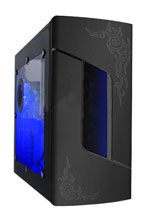 |
The case and power supply are the Sigma 500W La Vie mid-tower. This case and power supply are currently on sale after a $25 rebate for $40. Sigma makes both decent cases and decent power supplies that are sold separately. While no one will mistake this case/PSU combo for one of the premium Sigma offerings, it is still good quality and good value for a very reasonable price. Even if you pay the regular price of $60 to $65 you will get good value in this combo. We have built several entry systems with the Sigma case and PSU and had good results and stable performance. The only caveat is to check out the case when it arrives as shipping can take its toll on the case front door.
If you prefer a smaller case to mate with your Micro ATX motherboard the HEC 6K28BSOH48D Micro ATX mini-tower used in the Intel entry system is a good choice. It is a solid small case with a power supply from HEC, which is one of the world's best PSU makers. You should generally go for the best case and power supply you can reasonably afford, so you should also look at the cases and power supplies recommended for more expensive systems if you plan to keep your case/PSU and merely upgrade other components in the future.
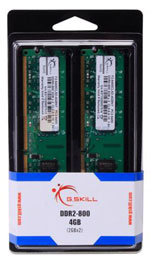 |
With DDR2 prices so very low, we went for 4GB of DDR2-800 this time. This is double last year's entry recommendation for less than half the price. This 50% to 75% drop in DDR2-800 memory prices in the past year is why you're not seeing much memory advertising these days. RAM prices as a whole are certainly in the commodity category as of late. We recommended the G.Skill 4GB DDR2-800 CAS 5 kit, but you could just as easily choose OCZ, Kingston, Corsair, Crucial, Geil, Patriot, A-Data or any other quality DDR2-800 name and shop for the memory based on a combination of price and the company's support reputation. Again, if you are truly pinching pennies you can save about $18 by going with a 2GB DDR2-800 kit instead at $19 to $20.
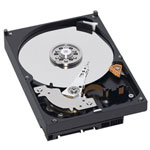 |
Hard drive capacity continues to grow, as you can see in our selection of the Western Digital Caviar 500GB for our entry system. It seems a waste to choose a lower HD capacity when 500GB is now available for around $60 - even from www.amazon.com. While there are differences between hard drives, outside of running benchmarks most people aren't likely to notice the difference in performance between Western Digital, Seagate, Samsung, Hitachi and other major brands. All are worthy of consideration if the price per gigabyte (or terabyte) is right.
 |
For the optical drive we went for value with the dependable Samsung 22X DVD. With the rise of the 25GB/50GB Blu-ray burners, DVD writers have continued to drop in price. A DVD writer that supports double-layer and 22X DVD writes for $25 is a bargain indeed.
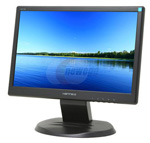 |
The last major component to discuss is the display, and here the tilt was toward price. $99 is a really low price for an LCD monitor, and the Hanns-G is a 17" widescreen that supports a native resolution of 1440x900. This is the resolution supported by most 19" and 20" widescreen monitors. You will not give up resolution with this monitor, but things will be a bit smaller.
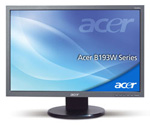 |
If your budget allows, you can choose the 19" Acer X193Wb with the same 1440x900 resolution at $120, or a 21.5" Viewsonic VX2233wm with true HD 1920x1080 resolution at $170. 21.5"/22" True HD is today's sweet spot, since the next step up to 23.6"/24" starts around $250. If your budget can stretch to $170, that is money well spent on a 21.5" 16:9 HD widescreen display.










66 Comments
View All Comments
JarredWalton - Monday, March 16, 2009 - link
We mentioned the benefits of tri-core for video encoding. Also remember that the latest AMD CPUs are 45nm, while the older non-Phenom chips are dual-core 65nm. I think the tri-core chip may actually be the lower power option at this point - it's certainly not going to be significantly hotter while it will be more powerful. Personally, I'd go for Phenom just to get the updated architecture and other improvements, as the dual-core chips are now based on a design that was state-of-the-art several years back. Until AMD moves the Phenom/K10 base design into dual-core, that will continue to be an advantage of the tri-core and quad-core chips.StormyParis - Monday, March 16, 2009 - link
As you say, it seems AMD has pretty much achieved parity processor-wise, at any given price point except the highest where AMD just really has no product.The MBs for AMD processors are always significantly cheaper than the equivalent for Intel CPUs, which tilts the balance. Why is that ?
Goty - Monday, March 16, 2009 - link
I'm assuming it comes down to the fact that AMD's chipset logic needs to be much less complex than Intel's due to the fact that there is no memory controller. This would allow AMD's chipsets to be smaller, cheaper to manufacture, and cheaper to sell to motherboard makers, thus helping to lower the cost for the end-user.I'm sure this isn't the only reason, seeing as how the actual chipset isn't too expensive either way, but things like the complexity of the PCB needed, the number of surface mount components, etc, probably make up for the rest of it.
just4U - Tuesday, March 17, 2009 - link
Not only that but for the last little while amd has been stuck in the budget bin so alot of the MB's that were popular sellers were in that catagory(manufactuers know whats selling whats not).Jaramin - Monday, March 16, 2009 - link
There are two mistakes in the Intel budget article, in the motherboard section.First, it refers to a E7300 CPU, while the CPU is a E7500. Second, and most important, the motherboard has NO integrated graphics. Either change the mobo, or include an entry level discrete GPU. In any case, you'll have to update the price listing...
mariush - Thursday, March 19, 2009 - link
The AMD Entry Level PC lists:Athlon 64 X2 7750 Kuma 2.7GHz Black Edition (2.7GHzx2 95W 2x512MB L2)
I don't know how they managed to fit 2x 512Megabytes of cache in it...maybe it's KB?
Wesley Fink - Friday, March 20, 2009 - link
Thanks for bringing this to our attention. Now corrected.Wesley Fink - Monday, March 16, 2009 - link
My apologies for the error. We are correcting the error as I type this. The last guide revision did include the Gigabyte GA-E7AUM-DS2H nVidia GeForce 9400, which is a 9400 chipset Integrated Graphics board. However, when it went to post the $120 price and Gigabyte was right, but the description was the non-integrated board from tn\he earlier Budget Guide.The board name and picture are now corrected. The updated description will post shortly.
Jaramin - Monday, March 16, 2009 - link
The price for the motherboard is still wrong. 120$ in the budget system, 135$ in the HTPC, same motherboard.Wesley Fink - Monday, March 16, 2009 - link
You have revealed one of the biggest problems with publishing prices - they change faster than you can post them. We changed the board in the Intel Budget system this morning to the Gigabyte with the nVidia 9400 chipset and used the correct for today $120 price. We had not corrected the Intel HTPS same board which was still showing the previous price of $135. The HTPC price has now been corrected. Hopefully it will remain accurate for a few days.